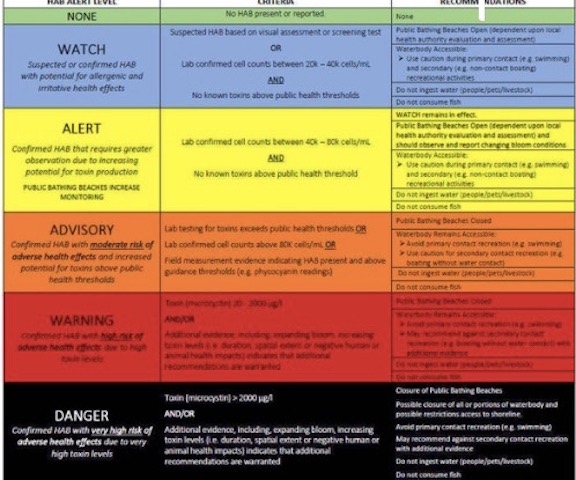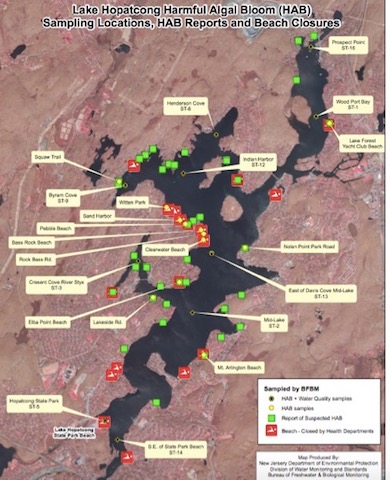Murphy DEP Rolled Back Toxic Harmful Algae Bloom (HAB) Standards by 400%
DEP Failing to Implement & Enforce Clean Water Programs Design To Protect Lakes
DEP grants buy watershed group support
Color coded tiered scheme masks rollback of standards
Just as critics predicted during last summer’s statewide proliferation of toxic Harmful Algae Blooms (HABs) that closed numerous lakes across the state, including NJ’s largest recreation lake, Lake Hopatcong, HAB’s are becoming a chronic problem.
They’re already back again this year.
But instead of developing a stronger and aggressive new program over the winter to better protect NJ’s lakes from the combined impacts of climate change and excessive nutrient pollution, remarkably, the Murphy DEP actually weakened the HAB standard by 400%.
(See new DEP science and strategy – It’s complex. Let’s just say I’ve never seen DEP adopt this kind of probability based health standard before, and it’s not really even a standard, it’ a statistical exceedence of an indicator of a Guidance value. The multi-step DEP screening process is familiar, though. It serves as a multi-step way to delay, reduce, or avoid controversial or costly responses (like recreational lake closures) and provides loopholes and safe “exit ramps” along the way. DEP does something similar in the TMDL program and the NJPDES phosphorus WQBEL Guidance with chlorophyll a. In addition to the complexity and multiple steps, vague bureaucratic euphemisms and admissions like this are all you need to know (@p.21):
DEP will make every effort to respond to reported suspected HABs as soon as possible. In the event that resources are limited, the response actions will be prioritized based on potential risk to public health.[…
Situational awareness in accordance with established internal DEP protocols will be initiated.
An agreed upon surveillance frequency which will consider recreational use, HAB extent, and other factors will be employed. ….
These advisories may be modified on a site-specific basis as appropriate to reflect the nature and extent of a specific HAB occurrence.
Last year, DEP issued public health warnings that resulted in closure of lakes to direct contact recreational uses (swimming, wind surfing, etc) when bacterial levels exceeded 20,000 cells/ml.
[Update: Here is DEP HAB monitoring data from 2019 for Lake Hopatcong -note that the NJ Health Advisory Guidance Level is 20,000 cells/ml. Note that DEP applied a 2 color scheme, based on that 20,000 cells/ml Guidance Level:
NJ Health Advisory Guidance Levels include cell counts ≥ 20,000 cells/ml andmicrocystin levels ≥ 3μg/L. While many HAB cell counts in Lake Hopatcong have been above NJ HealthAdvisory Guidance Levels, measurable microcystin levels have been below the guidance. …[…]
The scale below estimates the pigment concentrations and cell counts; the bright yellow to red is estimated to be over 20,000 cells/ml or higher, light green denotes an area of concern where cell counts may be near 20,000 cells/ml and dark gray denotes low levels or non-detect. ~~~ see map below.
Another smoking gun regarding the rollback of the 2019 20,000 cell/ml Health Advisory is this bullet item from the minutes of DEP’s Water Monitoring Council January 2020 meeting on HAB’s:
- Explore Additional Advisory Tiers for HAB Strategy based on DSR research and BFBM analyses of cell counts and toxin results.
It is shocking that the press and environmental groups are either intentionally ignoring this rollback or they are not reading the DEP documents. ~~~ end update]
But buried in the fine print of DEP’s new “color coded” scheme, that warning and closure level was increased fourfold (400%), to 80,000 cells/ml.
Surprisingly, only former Star Ledger outdoors reporter Fred Aun caught that massive rollback.
In an online publication, Fred wrote:
The state was criticized by many last summer for warning people to stay out of the water if cell counts of cyanobacteria – the microorganisms in HABs – reached 20,000 cells/ml. Many said the level was too low to warrant concern. […]“Based on data collected over the past three years, in particular last year, DEP scientists determined that harmful algal blooms become statistically more likely to produce toxins when cell counts exceed 80,000 per milliliter,” said the state. “Consequently, the DEP has developed this cell count level as the benchmark for posting recreational alerts where all primary recreation including swimming is not recommended and local health authorities close beaches.”
DEP caved in to the local political pressure and rolled back the standard from 20,000 to 80,000. That is outrageous.
Other press reports on the Murphy DEP’s Harmful Algae Bloom (HAB) program not only failed to note that massive weakening of public health protections (cynically masked under the guise of a new color coded warning scheme), but actually quoted Bill Kibler, a NJ environmentalists, who instead of slamming DEP for this massive political concession and standards rollback, shifted the focus away from DEP and to new local “stormwater utilities”.
I reached out to NJ Spotlight Reporter Jon Hurdle and Bill, advised them both of the rollback, and asked them why that was not reported by NJ Spotlight.
Normally, a 400% rollback in a health based water quality standard would trigger severe criticism from NJ environmental groups and garner press attention.
At least Jon Hurdle responded and said I raised a good point. Bill Kibler didn’t even respond. That ought to tell you something.
Which is why I’m not surprised that yesterday – likely in an effort to again dodge accountability for the huge rollback of the 20,000 cells/ml standard – DEP issued a press release on their new and improved HAB program. In that press release, DEP again trotted out their sycophantic fake green cheerleaders (but not Bill Kibler, who is now wise to their BS), to praise the initiative. DEP wrote:
“The Watershed Institute applauds the DEP for creating the new interactive mapping tool, and we look forward to using it in our efforts to keep water clean, safe, and healthy,” said Jim Waltman, the Watershed Institute’s Executive Director. “The DEP is taking an important step to raise awareness of the health of our waterways by making information about water pollution more accessible to the public. We hope through this tool, the public can better protect themselves and start to understand the impacts pollution has on all of us.”
But why would a watershed advocate praise a four fold rollback in a health based standard?
Here’s why so called environmentalists are praising DEP – they are being paid to do so by DEP:
Using a $240,000 [DEP] Community Water Monitoring grant, the nonprofit Watershed Institute is also training community water monitoring groups to assist with surveillance and sampling of lakes with suspected HABs.
What corrupt bastards. Have they no shame? Did they ever hear of a conflict of interest?
But in addition to weakening the bacterial standard, there are many other things DEP could be but is NOT DOING TO BETTER PROTECT LAKES UNDER CURRENT REGULATIONS AND DEP PROGRAMS.
If DEP were serious, here is a list of some of the things DEP would do under existing regulations and programs to create a new comprehensive statewide program to better protect lakes from climate and excessive nutrient loads (instead of what they are doing, which ignores prevention and is limited to response to problems, and amounts to 1) abdicating clean water and land use statutory obligations and regulatory authority; 2) outsourcing to DEP funded watershed groups; 3) delegating to local governments; 4) pointing the finger at local governments; 5) diverting attention to “stormwater utilities”; and 6) relying on NJ Department of Health and local health officials who are already over-burdened by COVID.)
DEP could and should:
1. Beef up the Clean Water Act based DEP Lakes Management Program (over the years, it has been neglected, defunded, or abandoned, e.g. see: Christie Whitman’s Executive Order #115:
WHEREAS, a large number of these lakes are exhibiting indications of stresses to water quality, including sedimentation, excess growth of nuisance and exotic plant and algal species, and other symptoms of eutrophication;
2. Strengthen the DEP “Total Maximum Daily Loads” (TMDLs) for lake nutrients. The TMDL’s are flawed and there is no implementation of enforcement.
3. DEP could adopt regulations to mandate local septic management programs in the DEP “water quality management planning” program and regulations – including more stringent siting, design, replacement, maintenance, pumpout, & pollution tracking requirements.
4. DEP Watershed Management Program – this program was supposed to address non-point pollution on a regional scale. It could become the umbrella under which DEP addressed the HAB problem.
5. DEP stormwater management program (weak technical standards and no enforcement)
6. DEP surface water quality standards (no enforceable numeric standards for eutrophication and no implementation of existing SWQS to protect lakes).
7. DEP septic design and management regulations – and lack of mandatory location, inspection, pompout, and pollutant tracing requirements
8. strengthen DEP’s Highlands Act regulations to limit the use of fertilizers (agricultural and residential), restrict development, restore riparian lands, and track and control nutrient sources.
9. DEP Wetlands Forestry BMP is voluntary and non-enforceable and lacks protections for wetlands and lake/stream vegetated buffers.
10. DEP could use all of the above programs’ science, data, staff, funding, and regulatory authority to design a comprehensive and regulatory “Lakes Management” Program to address HAB’s. But that would take political will and creativity, things that are sorely lacking a DEP – along with a watershed and environmental community that elevated science, integrity and the public interest above securing grant funds and providing cover and political loyalty to the Murphy administration.
When you look at all the DEP responsibility and legal authority under these programs and DEP’s failure to implement them, then maybe you can understand my frustration with DEP and sycophantic environmental groups proposing stormwater utilities and local controls as the answer.
And for so called watershed groups – who are taking money from DEP – to ignore all that, including a standards rollback – is totally corrupt.

